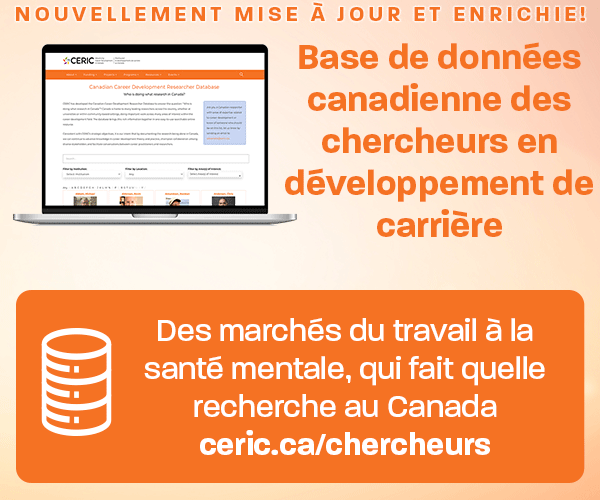Effet de l'information sur le marché du travail (IMT) : Comparaison entre l'utilisation indépendante et assistée de l'IMT
Résumé
D’après une importante méta-analyse (Brown et Ryan Krane, 2000), l’information sur le marché du travail (IMT) est un ingrédient critique à l’atteinte des objectifs de carrière des personnes. La présente étude a pour but de vérifier l’effet de l’utilisation de l’IMT, soit avec l’aide d’un conseiller ou sans son aide, et ce, en tenant compte de la possible présence d’effets différentiels liés au besoin de consultation des clients (choix de carrière ou recherche d’emploi). Pour ce faire, des personnes (n = 203) consultant dans des Centres d’emploi situés au Nouveau-Brunswick et en Saskatchewan ont été assignées de manière aléatoire à une méthode autonome (utilisation de l’IMT sans l’assistance d’un conseiller) ou assistée (utilisation de l’IMT avec l’assistance d’un conseiller). Les résultats suggèrent que l’effet de l’IMT dans le temps, bien qu’il soit significatif chez les deux groupes, s’avère plus important lorsque les participants sont assistés par un conseiller. Sur le plan de la signification clinique, cet effet est de taille moyenne (Cohen, 1988). Ce résultat ne diffère pas significativement selon le besoin de consultation des participants.
Références
Amir, T., Gati, I. and Kleiman, T. (2008). “Understanding and Interpreting Career Decision-Making Difficulties”. Journal of Career Assessment, 16(3), pp. 281–309.
Amundson, N. E. (2000). Connecting Career Development and Public Policy with Counsellling Process Issues. Vancouver, BC: University of British Columbia.
Amundson, N., Harris-Bowlsbey, J. and Niles, S. (2009). Essential Elements of Career Counselling: Processes and Techniques (2nd ed.). New Jersey, NJ: Pearson (1st ed. 2005).
Baltz, C. (1995). “Le concept d'information: essai de definition”. Communication, 16(2), pp. 163–176.
Baudouin, R., Bezanson, M. L., Borgen, W., Goyer, L., Hiebert, B., Lalande, V., Magnusson, K. et al., (2007). “Demonstrating Value: A Draft Framework for Evaluating the Effectiveness of Career Development Interventions”. Canadian Journal of Counsellling, 41, pp. 146–157.Bernaud, J.-L. (2014). Méthodes de tests et questionnaires en psychologie. Paris: Dunod.
Bernaud, J.-L. Di Fabio, A. and Saint-Denis, C. (2010). “Effets subjectifs du conseil en orientation et satisfaction des usagers : une analyse des processus et des determinants”. Revue canadienne de counselling, 44(3), pp. 307–325.
Bougnoux, D. (1995). La communication contre l'information. Paris: Hachette.
Brown, S. and Ryan Krane, N. E. (2000). “Four (or Five) Sessions and a Cloud of Dust: Old Assumptions and New Observations about Career Counselling”. In Brown S. and Lent R.W. (dir.), Handbook of Counselling Psychology (3rd ed.), pp. 740–766. New York, NY: Wiley.
Cohen, J. (1988). Statistical Power Analysis for the Behavioral Sciences (2nd ed.). Hillsdale, NJ: Lawrence Erlbaum Associates, Inc. (1st ed. 1969).
Creswell, J.W. (2014). Research Design: Qualitative, Quantitative and Mixed Methods Approaches (4th ed.). Thousand Oaks, CA: Sage.
Drennan, J. and Hyde, A. (2008). “Controlling Response Shift Bias: The Use of the Retrospective Pre-test Design in the Evaluation of a Master's Programme”. Assessment and Evaluation in Higher Education, 33(6), pp. 699–709.
Field, A. (2009). Discovering Statistics Using SPSS (3rd ed.). London: Sage Publications Ltd. (1st ed. 2000).
Foskett, J. and Hemsley-Brown, J. V. (1999). “Invisibility, Perceptions and Image: Mapping the Career Choice Landscape”. Research in Post-Compulsory Education, 4, pp. 233–248.
Gati, I. and Levin, N. (2015). “Making Better Career Decisions”. In P. J. Hartung, M. L. Savickas and W. B. Walsh (dir.), Handbook of Career Intervention, pp. 193–207. Washington, WA: American Psychological Association.
Gati, I. and Tal, S. (2008). “Decision-Making Models and Career Guidance”. In J. Athanasou and R. Van Esbroeck (dir.), International Handbook of Career Guidance, pp. 157–185. Berlin, Germany: Springer.
Gottfredson, L. S. (1996). “Gottfredson’s Theory of Circumscription and Compromise”. In D. Brown, L. Brooks and coll. (dir.), Career Choice and Development(3rd ed.), pp. 179–232. San Francisco: Jossey-Bass.
Gysbers, N. C., Heppner, M. J. and Johnston, J.A. (2014). Career Counselling: Holism, Diversity, and Strengths (4th ed.). Alexandria, VA: American Counselling Association (1st ed. 1998).
Heppner, P., Kivlighan, D. and Wampold, B. (2008). Research Design in Counselling (3rd ed.). Belmont, CA: Thomson Higher Education (1st ed. 1999).
Hiebert, B. (2012). Assessing the impact of labour market information : Final report on results of phase two (field tests). Ottawa : Ressources humaines et développement des compétences Canada.
Kleiman, T. and Gati, I. (2004). “Challenges of Internet-Based Assessment: Measuring Career Decision-Making Difficulties”. Measurement and Evaluation in Counselling and Development, 37, pp. 41–55.
Krieshok, T. S., Black, M .D. and McKay, R. A. (2009). “Career Decision Making: The Limits of Rationality and the Abundance of Non-Conscious Processes”. Journal of Vocational Behavior, 75, pp. 275–290.
Labour Market Information Advisory Panel (2009). Working Together to Build a Better Labour Market Information System for Canada, Final Report. Minister of Human Resources and Skills Development Canada and Minister for Post-Secondary Education, Training and Labour of New Brunswick.
Masdonati, J., Perdrix, S., Massoudi, K. and Rossier, J. (2014). “Working Alliance as a Moderator and a Mediator of Career Counselling Effectiveness”. Journal of Career Assessment, 22(1), pp. 3–17.
Multon, K. D., Wood, R., Heppner, M. J. and Gysbers, N. C. (2007). “A Cluster-Analytic Investigation of Subtypes of Adult Career Counselling Clients: Toward a Taxonomy of Career Problems”. Journal of Career Assessment, 15(1), pp. 66–86.
Organisation de coopération et de développement économiques. (2013). Les grandes mutations qui transforment l’éducation 2013. Downloadable document available at < http://www.keepeek.com/Digital-Asset-Management/oecd/education/les-grandes-mutations-qui-transforment-l-education-2013_trends_edu-2013-fr#page1>. Viewed on October 7, 2013.
Patton, W. and McCrindle, A. (2001). “Senior Students' Views on Career Information”. Australian Journal of Career Development, 10(1), pp. 32–36.
Pratt, C.C., McGuigan, W.M. and Katzev, A.R. (2000). “Measuring Program Outcomes: Using Retrospective Pretest Methodology”. American Journal of Evaluation, 21(3), pp. 341–349.
Rochlen, A. B., Milburn, L. and Hill, C. E. (2004). “Examining the Process and Outcome of Career Counselling for Different Types of Career Counselling Clients”. Journal of Career Development, 30(4), pp. 263–275.
Rockwell, S.K. and Kohn, H. (1989). “Post-then-Pre Evaluation”. Journal of Extension, 27(2), pp. 19–21.
Sampson, J. P., Reardon, R. C., Peterson, G. W. and Lenz, J. G. (2004). Career Counselling and Services: A Cognitive Information Processing Approach. Pacific Grove, CA: Brooks/Cole.
Sampson, J. P., Lenz, J. G., Peterson, G. W. and Reardon, Effect of Labour Market Information (LMI)52R. C. (1999). “A Cognitive Information Processing Approach to Employment Problem Solving and Decision Making”. The Career Development Quarterly, 48(1), pp. 3–18.
Savard, R., Gingras, M. and Turcotte. M. (2002). “Delivery of Career Development Information in the Context of Information Computer Technology”. International Journal for Educational and Vocational Guidance, 2, pp. 173–191.
Savard, R., Michaud, G., Bilodeau, C. and Arsenau, S. (2007). “L’effet de l’information sur le marché du travail dans le processus décisionnel relatif au choix de carrière”. Canadian Journal of Counsellling/Revue canadienne de counselling, 41(3), pp. 158–172.
Savard, R. et Paquette, S. (2012). Mesure de l’effet de l’information sur le marché du travail : rapport final de la phase II, résultats de l’analyse des questionnaires. Ottawa : Ressources humaines et développement des compétences Canada.
Savickas, M. L. (1999). “Career Development and Public Policy: The Role of Values, Theory and Research”. In B. Hiebert & L. Bezanson (Eds.), Making Waves: Career Development and Public Policy: International Symposium 1999, Papers, Proceedings and Strategies(pp. 52–68). Ottawa, ON: Canadian Career Development Foundation.
Sharpe, A. (2009). Pratiques exemplaires en ce qui a trait à l’information sur le marché du travail: Recommandations pour le système d’IMT du Canada. CENV 2009-5 research report.
Tabachbick, B. G. and Fidell, L. S. (2001). Using Multivariate Statistics (4th ed). Needham Heights, MA: Allyn and Bacon.
Thuy, P. E., Hansen, E. and Price, D. (2001). The Public Employment Service in a Changing Labour Market. Geneva: IOL.
Whiston, S. C., Sexton, T. L.and Lasoff, D. L. (1998). “Career-Intervention Outcome: A Replication and Extension of Oliver and Spokane (1988)”. Journal of Counselling Psychology, 45(2), pp

Téléchargements
Publié-e
Comment citer
Numéro
Rubrique
Licence

Cette œuvre est sous licence Creative Commons Attribution - Pas d'Utilisation Commerciale - Pas de Modification 4.0 International.











